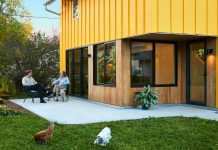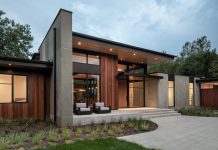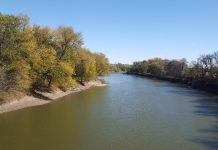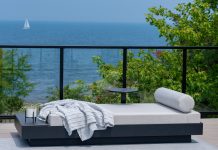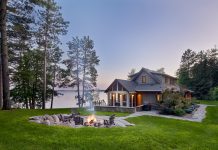Photos by Tracy Walsh


When Lynn Dobson and Tony Thoe bought their mid-century modern home in St. Paul in 2011, they became the third owners of the unique property, which was featured in Better Homes and Gardens in 1953, just one year after the house was built. Situated on a steep hillside on a heavily wooded lot, the home was built on land that had once been part of Oliver Crosby’s grand Stonebridge Estate.
An inventor and founder of the successful manufacturing company, American Hoist and Derrick, Crosby purchased 48 acres of land in St. Paul’s Macalester-Groveland neighborhood in 1907 and built an estate that included a 20,000-square-foot mansion, two artificial lakes, waterfalls, a city-block-long mall that extended to the river bluffs, an arboretum, a greenhouse, several gardens, and more. Crosby died just six years after his family moved into the mansion, and once his wife and other extended family passed, the property fell into disrepair and was slowly portioned off and sold.
Dobson and Thoe’s street was one of the last sections of the estate to be redeveloped because the hillside was considered too difficult to build on, but modern architecture turned out to be a perfect solution for the tough site. After eight years of hard work, the owners have managed to tame, terrace, and garden their unusual lot into something truly spectacular.
Their first task was to clear weeds, brush, and 18 weed trees from the front and back yards. In the process, they discovered the central feature of their backyard: a cascading waterfall and stream bed. Long ago, water was pumped from the Mississippi River into the downward flowing stream, which Dobson and Thoe now maintain as a recirculating system fed by a pool at the bottom of the hill.
Terracing came next, as did rebuilding the crumbling back patio and surrounding stone wall. But it was figuring out what to plant that had been an ongoing project. Both owners love to garden, so they were a bit disappointed at first to find the lot’s mature trees left them little sun for growing colorful flowers. But over time, they’ve learned how to successfully combine perennials in eye-catching ways by focusing on plants’ shapes, textures, and foliage. “We’re constantly looking for different plants that like the shade and our sandy soil,” Dobson says, explaining how they had never really given hostas much thought until recently. “Now, we’re enthused about them and have assembled quite a collection that we’re really proud of.”
To add color and a bit of whimsy, Dobson and Thoe collect sculptures of goats, pelicans, and other creatures that can be seen throughout the yard, but among the most striking are the many fish statues that meander the stream before the waterfall. Granite slabs serve as steps across the water, making it possible to walk through the gardens on the steep hillside in one continuous loop. “People always get excited when they see that hillside,” Dobson says. “It has been a blessing in many ways, but it’s also been a real challenge—maybe the biggest challenge I’ve ever dealt with.” Even so, it’s a challenge the two have risen to and overcome in a skillful, artistic way.

Plants for Shade and Sandy Soil
Shade gardens can be peaceful and interesting in ways sunny, colorful gardens often cannot. The key is to find the right plants. If you have shade and sandy soil, try planting varieties of these tried-and-true perennials: ajuga, bellwort, Christmas fern, columbine, daylilies, dead nettle, foxglove, goatsbeard, hostas, lady fern, pachysandra, periwinkle, Siberian squill, snowdrops, Solomon’s seal, wild ginger, and yarrow.


